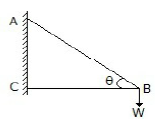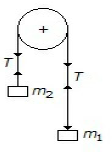The static friction
Bears a constant ratio to the normal reaction between the two surfaces
Is independent of the area of contact, between the two surfaces
Always acts in a direction, opposite to that in which the body tends to move
All of the above
Correct Answer :
D. All of the above
Related Questions
The unit of power in S.I. units is
Horsepower
Joule
Watt
kg-m
Which one of the following statements is not correct?
The tangent of the angle of friction is equal to coefficient of friction
The angle of repose is equal to angle of friction
The tangent of the angle of repose is equal to coefficient of friction
The sine of the angle of repose is equal to coefficient to friction
The maximum efficiency of a lifting machine is
1/m
V.R./m
m/V.R.
1/(m × V.R.)
A cable with a uniformly distributed load per horizontal meter run will take the following shape
Straight line
Parabola
Hyperbola
Elliptical
A particle inside a hollow sphere of radius r, having coefficient of friction μ can rest up to height of
r/2
r/A
r/3
0.134 r
In a framed structure, as shown in the below figure, the forces in the members AB and BC are respectively 
√3. W (tensile) and 2W (compressive)
2W (tensile) and √3. W (compressive)
2√3. W (tensile) and 2√3. W (compressive)
None of the above
If a rigid body is in equilibrium under the action of three forces, then
These forces are equal
The lines of action of these forces meet in a point
The lines of action of these forces are parallel
Both (B) and (C) above
In a framed structure, as shown in the below figure, the force in the member BC is 
W/√3 (compression)
W/√3 (tension)
2W/√3 (compression)
2W/√3 (tension)
Forces are called concurrent when their lines of action meet in
One point
Two points
Plane
Perpendicular planes
When the spring of a watch is wound, it will possess
Strain energy
Kinetic energy
Heat energy
Electrical energy
The resultant of the following three couples 20 kg force, 0.5 m arm, +ve sense 30 kg force, 1 m arm, -ve sense 40 kg force, 0.25 m arm, +ve sense having arm of 0.5 m will be
20 kg, -ve sense
20 kg, + ve sense
10 kg, + ve sense
10 kg, -ve sense
The periodic time of a particle with simple harmonic motion is __________ proportional to the angular velocity.
Directly
Inversely
Square root
None of these
A projectile is fired at an angle θ to the vertical. Its horizontal range will be maximum when θ is
0°
30°
45°
60°
The velocity of a particle (v) moving with simple harmonic motion, at any instant is given by (where r = Amplitude of motion, and y = Displacement of the particle from mean position.)
ω.√(y² - r²)
ω.√(r² - y²)
ω².√(y² - r²)
ω².√(r² - y²)
The force induced in the string AB due to the load W, as shown in the below figure is 
W sinθ
W cosθ
W secθ
W cosecθ
The potential energy of a vertically raised body is __________ the kinetic energy of a vertically falling body.
Equal to
Less than
Greater than
None of these
The resultant of two equal forces P making an angle θ, is given by
2P sinθ/2
2P cosθ/2
2P tanθ/2
2P cotθ/2
Two bodies of masses m1 and m2 are hung from the ends of a rope, passing over a frictionless pulley as shown in the figure below. The acceleration of the string will be 
g (m1 - m2)/(m1 + m2)
2g (m1 - m2)/(m1 + m2)
g (m1 + m2)/(m1 - m2)
2g (m1 + m2)/(m1 - m2)
The centre of gravity of a triangle lies at the point of
Concurrence of the medians
Intersection of its altitudes
Intersection of bisector of angles
Intersection of diagonals
In determining stresses in frames by methods of sections, the frame is divided into two parts by an imaginary section drawn in such a way as not to cut more than
Two members with unknown forces of the frame
Three members with unknown forces of the frame
Four members with unknown forces of the frame
Three members with known forces of the frame
The centre of percussion is below the centre of gravity of the body and is at a distance equal to
h/kG
h2/kG
kG2/h
h × kG
D' Alembert's principle is used for
Reducing the problem of kinetics to equivalent statics problem
Determining stresses in the truss
Stability of floating bodies
Designing safe structures
Which of the following is not a vector quantity?
Weight
Velocity
Acceleration
Force
The maximum frictional force, which comes into play, when a body just begins to slide over the surface of the other body, is known as
Static friction
Dynamic friction
Limiting friction
Coefficient of friction
The velocity ratio of a simple wheel and axle with D and d as the diameters of effort wheel and load axle, is
D + d
D - d
D × d
D / d
In a screw jack, the effort required to lower the load is __________ the effort required to raise the same load.
Less than
Equal to
More than
None of these
The friction experienced by a body, when at rest, is known as
Static friction
Dynamic friction
Limiting friction
Coefficient of friction
The law of the machine is (where P = Effort applied to lift the load, m = A constant which is equal to the slope of the line, W = Load lifted, and C = Another constant which represents the machine friction.)
P = mW - C
P = m/W + C
P = mW + C
P = C - mW
The necessary condition for forces to be in equilibrium is that these should be
Coplanar
Meet at one point
Both (A) and (B) above
All be equal
The unit of energy in S.I. units is
Dyne
Watt
kg-m
Joule
